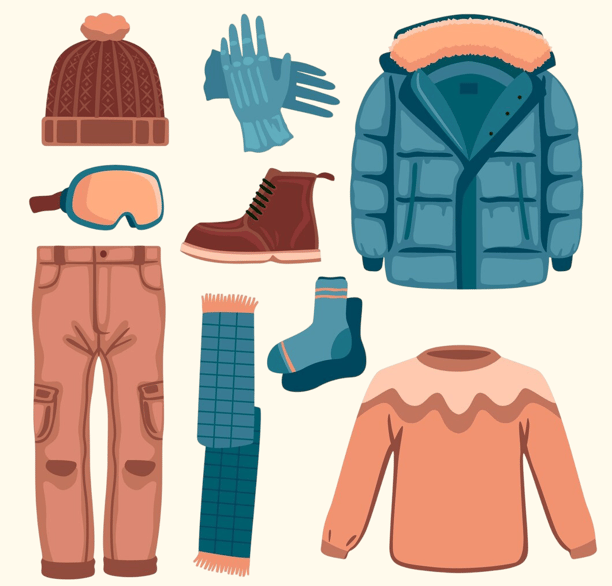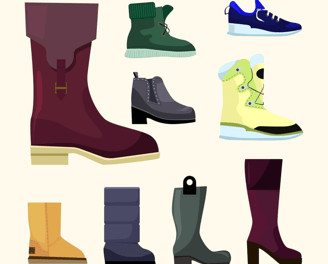Clothing and Blankets
Insulated gear is recommended for cold weather, and lightweight, breathable clothing is recommended for hot climates. Proper clothing and blankets are essential for maintaining body temperature, protecting against the elements, and ensuring comfort during emergencies. Preparing the right items for various scenarios can significantly improve your chances of survival.
PREPARE ESSENTIAL SUPPLIES
12/28/20242 min read
Clothing and Blankets
Insulated gear is recommended for cold weather, and lightweight, breathable clothing is recommended for hot climates.
Proper clothing and blankets are essential for maintaining body temperature, protecting against the elements, and ensuring comfort during emergencies. Preparing the right items for various scenarios can significantly improve your chances of survival.


1. Importance of Appropriate Clothing and Blankets
A. Temperature Regulation
Protects against hypothermia in cold conditions or heat exhaustion in hot environments.
Provides a barrier against wind, rain, and snow.
B. Physical Protection
Shields skin from injuries, insect bites, and harmful UV rays.
C. Psychological Comfort
Offers warmth and familiarity, boosting morale in stressful situations.
2. Essential Clothing Items
A. Layered Clothing System
Base Layer:
Wicks moisture away from the skin.
Materials: Merino wool or synthetic fabrics (avoid cotton as it retains moisture).
Middle Layer:
Provides insulation by trapping body heat.
Materials: Fleece or down.
Outer Layer:
Protects against wind, rain, and snow.
Materials: Waterproof and breathable fabrics like Gore-Tex.
B. Weather-Specific Clothing
Cold Weather:
Thermal underwear.
Insulated jackets and pants.
Hats, gloves, and scarves to cover extremities.
Hot Weather:
Lightweight, breathable clothing.
Hats with wide brims for sun protection.
Light-colored fabrics to reflect sunlight.
Rainy Conditions:
Waterproof jackets and pants.
Ponchos for quick cover.
Waterproof boots.
C. Footwear
Durable, weather-appropriate boots for walking or trekking.
Wool or synthetic socks to prevent blisters and keep feet dry.
D. Accessories
Gloves: For warmth or hand protection during labour.
Hats: Insulated for cold, wide-brimmed for sun.
Gaiters: Protect lower legs from debris, snow, or water.
3. Essential Blankets
A. Types of Blankets
Emergency (Mylar) Blankets:
Lightweight, compact, and reflective.
Retain body heat and are windproof and waterproof.
Wool Blankets:
Provide excellent insulation even when wet.
Durable and long-lasting.
Fleece Blankets:
Lightweight and quick-drying.
Comfortable for indoor or mild conditions.
Quilts and Comforters:
Good for stationary or indoor use.
Not as effective in outdoor, wet environments.
B. Blanket Features
Portability: Choose compact and lightweight blankets for mobility.
Durability: Opt for materials that withstand wear and tear.
Water Resistance: Essential for outdoor use.
4. Planning and Storage
A. Clothing
Pack a set of clothing for each family member in your "go-bag."
Rotate seasonally to match current weather conditions.
Vacuum-seal items for compact storage and protection from moisture.
B. Blankets
Store blankets in waterproof bags or containers.
Keep extra blankets in vehicles and shelters for emergencies.
5. Long-Term Survival Considerations
A. Versatile Clothing Choices
Choose multipurpose clothing that can be layered or adjusted.
Convertible pants or jackets with detachable liners offer flexibility.
B. Repair Kits
Carry a sewing kit for mending torn clothing or blankets.
Include patches and waterproof tape for quick fixes.
C. Washing and Maintenance
Plan for hand-washing clothes with biodegradable soap.
Use a clean area or tarp for drying in the sun.
6. Example Clothing and Blanket Kit
Clothing:
1 base layer set (top and bottom).
1 insulated middle layer.
1 waterproof jacket and pants.
2 pairs of wool socks.
1 hat and a pair of gloves.
Sturdy boots.
Blankets:
1 emergency blanket per person.
1 wool or fleece blanket for shared use.
Accessories:
Sewing kit.
Waterproof storage bags.
7. Common Mistakes to Avoid
Overlooking Layering: Avoid packing only bulky items; layers provide better adaptability.
Ignoring Footwear: Uncomfortable or inadequate shoes can lead to injuries.
Skipping Waterproofing: Ensure both clothing and blankets are protected against water.
Clothing and blankets are foundational to survival preparedness. By selecting versatile, weather-appropriate items and keeping them well-maintained, you can stay warm, protected, and comfortable during emergencies. Careful planning ensures you're ready for diverse situations, from sudden evacuations to extended outdoor survival.




